-
收藏模板
- 模板信息
- 更新时间:2023-09-24
- 字数:约6867字
- 页数:约5页
- 格式:.docx
- 推荐版本:Office2016及以上版本
- 售价:5 金币
您可能喜欢的文档
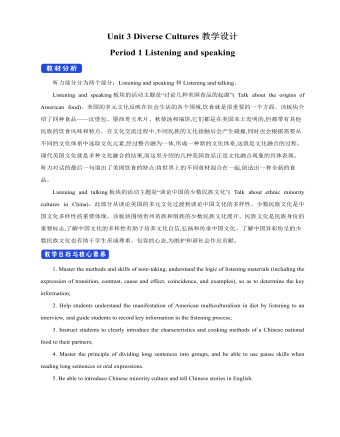
新人教版高中英语必修3Unit 3 Diverse Cultures教学设计一
Activity 81.Grasp the main idea of the listening.Listen to the tape and answer the following questions:Who are the two speakers in the listening? What is their relationship?What is the main idea of the first part of the listening? How about the second part?2.Complete the passage.Ask the students to quickly review the summaries of the two listening materials in activity 2. Then play the recording for the second time.Ask them to complete the passage and fill in the blanks.3.Play the recording again and ask the students to use the structure diagram to comb the information structure in the listening.(While listening, take notes. Capture key information quickly and accurately.)Step 8 Talking Activity 91.Focus on the listening text.Listen to the students and listen to the tape. Let them understand the attitudes of Wu Yue and Justin in the conversation.How does Wu Yue feel about Chinese minority cultures?What does Justin think of the Miao and Dong cultures?How do you know that?2.learn functional items that express concerns.Ask students to focus on the expressions listed in activity. 3.And try to analyze the meaning they convey, including praise (Super!).Agree (Exactly!)"(You're kidding.!)Tell me more about it. Tell me more about it.For example, "Yeah Sure." "Definitely!" "Certainly!" "No kidding!" "No wonder!" and so on.4.Ask the students to have conversations in small groups, acting as Jsim and his friends.Justin shares his travels in Guizhou with friends and his thoughts;Justin's friends should give appropriate feedback, express their interest in relevant information, and ask for information when necessary.In order to enrich the dialogue, teachers can expand and supplement the introduction of Miao, dong, Lusheng and Dong Dage.After the group practice, the teacher can choose several groups of students to show, and let the rest of the students listen carefully, after listening to the best performance of the group, and give at least two reasons.
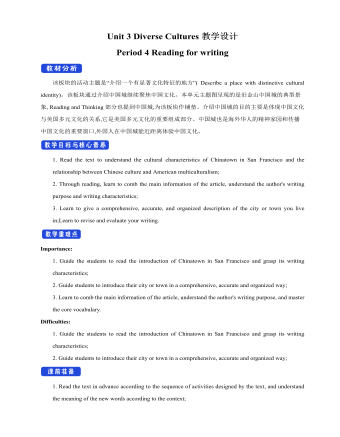
新人教版高中英语必修3Unit 3 Diverse Cultures教学设计四
该板块的活动主题是“介绍一个有显著文化特征的地方”( Describe a place with distinctive cultural identity)。该板块通过介绍中国城继续聚焦中国文化。本单元主题图呈现的是旧金山中国城的典型景象, Reading and Thinking部分也提到中国城,为该板块作铺垫。介绍中国城的目的主要是体现中国文化与美国多元文化的关系,它是美国多元文化的重要组成部分。中国城也是海外华人的精神家园和传播中国文化的重要窗口,外国人在中国城能近距离体验中国文化。1. Read the text to understand the cultural characteristics of Chinatown in San Francisco and the relationship between Chinese culture and American multiculturalism;2. Through reading, learn to comb the main information of the article, understand the author's writing purpose and writing characteristics;3. Learn to give a comprehensive, accurate, and organized description of the city or town you live in;Learn to revise and evaluate your writing.Importance:1. Guide the students to read the introduction of Chinatown in San Francisco and grasp its writing characteristics;2. Guide students to introduce their city or town in a comprehensive, accurate and organized way;3. Learn to comb the main information of the article, understand the author's writing purpose, and master the core vocabulary.
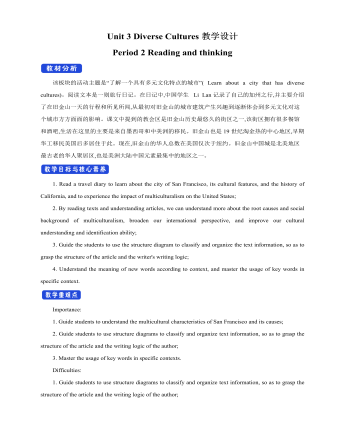
新人教版高中英语必修3Unit 3 Diverse Cultures教学设计二
(2)Consolidate key vocabulary.Ask the students to complete the exercises of activity 6 by themselves. Then ask them to check the answers with their partners.(The first language:Damage of the 1906 San Francisco earthquake and fire.A second language: Yunnan - one of the most diverse provinces in China).Step 5 Language points1. The teacher asks the students to read the text carefully, find out the more words and long and difficult sentences in the text and draw lines, understand the use of vocabulary, and analyze the structure of long and difficult sentences.2. The teacher explains and summarizes the usage of core vocabulary and asks the students to take notes.3. The teacher analyzes and explains the long and difficult sentences that the students don't understand, so that the students can understand them better.Step 6 Homework1. Read the text again, in-depth understanding of the text;2. Master the use of core vocabulary and understand the long and difficult sentences.3. Complete relevant exercises in the guide plan.1、通过本节内容学习,学生是否理解和掌握阅读文本中的新词汇的意义与用法;2、通过本节内容学习,学生能否结合文本特点了解文章的结构和作者的写作逻辑;3、通过本节内容学习,学生能否了解旧金山的城市风貌、文化特色,以及加利福尼亚州的历史,体会多元文化对美国的影响。
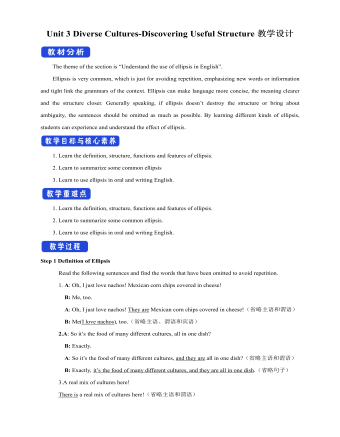
新人教版高中英语必修3Unit 3 Diverse Cultures-Discovering Useful Structure教学设计
Step 4 PracticeRead the conversation. Find out which words have been left out.Justin: Linlin, I’m going to Guizhou Province next month. I’m super excited! Any recommendations for places to visit?Linlin: Wow, cool! Guizhou is a province with a lot of cultural diversity. Places to visit...well, definitely the Huangguoshu Waterfall first.Justin: What’s special about the waterfall?Linlin: Well, have you ever heard of the Chinese novel Journey to the West ?Justin: Yes, I have. Why ?Linlin: In the back of the waterfall, you will find a cave, which is the home of the Monkey King.Justin: Really? Cool! I’ll definitely check it out.Linlin:And I strongly recommend the ethnic minority villages. You’ll find Chinese culture is much more diverse than you thought.Justin:Sounds great, thanks.Answers:Justin: Linlin, I’m going to Guizhou Province next month. I’m super excited! Do you have any recommendations for places to visit?Linlin: Wow, that’s cool! Guizhou is a province with a lot of cultural diversity. What are some places to visit in Guizhou ? Well, definitely the Huangguoshu Waterfall is the first place to visit in Guizhou Province.Justin: What’s special about the waterfall?Linlin: Well, have you ever heard of the Chinese novel Journey to the West ?Justin: Yes, I have heard of the Chinese novel Journey to the West . Why do you ask if I have heard of the Chinese novel Journey to the West?Linlin: In the back of the waterfall, you will find a cave, which is the home of the Monkey King from Journey to the West.Justin: That’s really true? It’s Cool! I’ll definitely check it out.Linlin:And I strongly recommend the ethnic minority villages on your trip to Guizhou Province. You’ll find Chinese culture is much more diverse than you thought it was.Justin:This all sounds great, thanks.
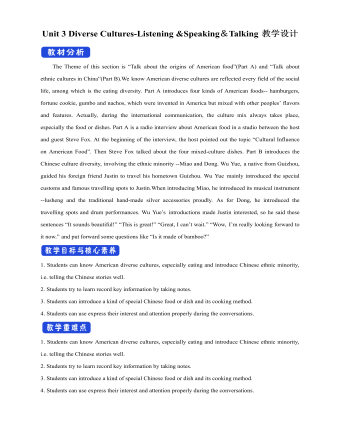
新人教版高中英语必修3Unit 3 Diverse Cultures-Listening &Speaking&Talking教学设计
1. In Picture 1 and Picture 2, where do you think they are from? How do you know?From their wearings, we can know they are from ethnic minority of China--- Miao and Dong.Picture 1, they are playing their traditional instrument lusheng in their traditional costumes.Picture 2. the girls are Miao because they wear their traditional costumes and silver accessory.2. In Picture 3, can you find which village it is? What time is it in the picture?It is Dong village. It is at night. Step 2 While-listeningJustin met a new friend while traveling in Guizhou. Listen to their conversation and complete the summaries below.Part 1Justin and Wu Yue watched some Miao people play the lusheng. The instrument has a history of over 3,000 years and it is even mentioned in the oldest collection of Chinese poetry. Then they watched the lusheng dance. Justin wanted to buy some hand-made silver/traditional accessories as souvenirs. He was told that the price will depend on the percentage of silver. Part 2They will go to a pretty Dong minority village called Zhaoxing. they will see the drum towers and the wind and rain bridges. They may also see a performance of the Grand Song of the Dong people.Step 3 Post-listening---TalkingWork in groups. Imagine Justin is telling some friends about his trip to Guizhou. One of you is Justin and the rest of you are his friends. Ask Justin questions about his trip and experience. The following expressions may help you.
- 查看更多相关Word文档
Unit 3 DiverseCultures教学设计
Period 3 Discovering Useful Structures
该板块的活动主题是“理解英语中省略的用法”(Understand the use of the ellipsis in English)。与汉语一样,英语中的省略也较为常见。省略是一种避免重复、突出新信息并使上下文紧密连接的语法手段。一般来说,只要不损害结构或引起歧义,能省略的地方就可以省略。省略可使语言更加简洁,意思更加明确,句子结构更加紧凑。本部分通过不同层次的语言学习活动,帮助学生体会使用省略的效果。

1. Ask students to analyze the omitted wordsin the sentence with the context, and understand the role of ellipsis;
2. Help students recover the omitted parts ofsentences according to the context or situation, and realize the effect ofomission;
3. Instruct students to summarize commonomissions and understand the role of omissions.
Importance:
1. Guide students to summarize commonomissions and understand the role of omissions;
2. Help students recover the omitted parts ofsentences according to the context or situation, and realize the effect ofomission;
Difficulties:
Recover the omitted parts of a sentenceaccording to the context or situation
1. Review ellipsis before class and point outits function;
2. Master the usage of ellipsis and perceivethe new ellipsis by combining with the relevant exercises of guiding cases.
Step 1 Revision
1.Present the following dialogue to thestudents and guide them to understand the use of ellipsis by asking questions:
Where is ellipsis used in the dialogue?Whatsmissing?
( 1)A: I’m hungry
B: Are you (hungry)?
A: Yeah.(I) Didnt have lunch today.
B:(Do you) Want some sandwiches?
A: Are there any?
B: Yeah. (I’ve) Just made some.
(2)A:(It) Looks like rain
B: Oh, I hope (it does) not(rain).
A: Why (do you hope it doesnt rain)?
B: We have a soccer game today, (do you) remember?
A: Do we (have a soccer game today )? Where (will it be)?
B: (It will be) In the bigger playground
Step 2 Learning new grammar
Activity 1
1. Ask students to find the sentences inactivity 1 in this unit and discuss the following questions in pairs:
①Why use ellipsis insentences?(clear meaning in the context, avoid repetition, make the structuremore compact, make the focus more prominent)
②What sentenceelements are omitted?(subject, predicate, object)
2. Ss read the dialogue and find out where ellipsisis used in the dialogue and what is missing.Then check their answers withclass.
1) (They are) Mexican corn chipscovered in cheese! (I love nachos), too.
2)…,(andthey are) all in one dishes? Exactly,(it’s the food of many differentcultures,and they are all in one dishes.)
3) (There is) a real mix of cultureshere!
4) (I) can’t wait (to go there)!
Step 3 Practice
Activity 2
Askstudents to complete activity 2. How to make a sentence by omitting theunnecessary parts of the sentence and comparing with the original sentence.
The child becomes concise.The teacher guidesthe students to summarize the different situations of using ellipsis in thesesentences and pays attention to the key cohesion in the sentences.
The first sentence is simple, the second,fifth and sixth are compound (but, and), and the third and fourth are compound(if necessary, as soon as possible, than).If when/whenever....+possible/necessary "and" as soon/fast/early/easy.+ as possible".
(Check their answers with class.)
Step 4 Summarizing
Guide the students tosummarize the usage of ellipsis.
一、基础点拨
为了避免重复或为了使句子更简练,在一些句子中常常省去某一个或某几个成分,这种语法现象在英语中叫作省略。
在英语句子中,常见的省略情况有以下几种:
(一)简单句中的省略
1.省略主语和谓语。
—Hello!Is Jack in?“你好!杰克在吗?”
—(This is)Jack speaking.“我就是。”
2.There be句型的省略。
(Is there)Anything wrong?
发生了什么事吗?
3.感叹句根据上下文的省略。
Whata (good) boy (he is)!
多好的男孩呀!
4.名词所有格修饰的名词若表示店铺、住宅、教堂或上下文已暗示或明确指出过的事物时可省略名词。
Igo to the supermarket instead of the butchers(shop) to buy meat.我去超市而不是去肉铺买肉。
5.介词的省略。
可以省略介词in的几个固定词组,如spendtime(in)doing sth.,have a hard time (in)doing sth.,waste time(in)doingsth.等。
Heseldom spends his spare time (in)studying.
他空余时间很少学习。
(二)并列句中的省略
1.省略共同的主语或宾语。
Tompicked up the book from the floor and(Tom)handedit to his brother.
汤姆从地板上捡起书并把它递给了他的哥哥。
2.若主语与谓语动词相同,则省略后面的主语和谓语。
Hisperformance made us amused,but(his performance made)himself tired.
他的表演让我们高兴,但是使他自己很累。
3.若主语不同而谓语的助动词、情态动词相同,则省略后面的助动词或情态动词。
Xiaomingmust have been playing football at that time,andhis sister(must have been)playingthe piano.
那时小明一定在踢足球,而他妹妹一定在弹钢琴。
(三)复合句中的省略
1.状语从句的省略。
(1)在when,while,whenever,till,as soon as,if,unless,as if,though等引导的状语从句中,若谓语含有be,而从句的主语与主句的主语相同或是it时,则从句的主语和be常被省略。
Hewill not attend the party unless(he is)invited.
除非被邀请,否则他不会参加这个宴会。
If(it is)convenient,please call me and have a chat with me.
如果方便的话,给我打电话聊天。
(2)虚拟条件句中若含有助动词were,had,should常省略if,将助动词were,had,should提前构成部分倒装。
WereI you(=If I were you),Iwill accept the chance to work in that company.
如果我是你,我会接受在那个公司工作的机会。
2.宾语从句中的省略。
(1)由特殊疑问词which,when,where及why引导的宾语从句,若从句中所表达的内容与主句内容重复,可将其省略,仅保留疑问词。
Hewas late for work again,and no one knew why(he was late for work again).
他又一次上班迟到了,没人知道为什么。
(2)that引导的宾语从句作动词的宾语时,可省略引导词that;若两个或两个以上的that引导的宾语从句作动词的宾语,只能省略第一个引导词that。
Joesaid(that)he would come and that hewould arrive at 5:00 p.m.
乔说过他要来,下午5点会到。
(3)在与suggest,request,order,advise等词有关的名词性从句中,从句谓语动词应用虚拟语气形式,即“should+动词原形”,should可以省略。
Isuggested that we (should) hold ameeting tonight.
我提议我们今晚开个会。
(4)在Im afraid,I think,I believe,I hope,I guess等作答句时,其后常跟省略形式。so表示赞同前述的事实,not表示不赞同前述的事实。
—Wewill have to work extra hours to finish the work.
“我们将不得不加班来完成这份工作。”
—Im afraid so(=we will have to work extra hours to finish the work).“恐怕是这样。”
3.定语从句的省略。
(1)在限制性定语从句中,作宾语用的关系代词whom,which,that可省略。
Hehanded the book(that/which)he boughtyesterday to me.
他把昨天买的那本书递给了我。
(2)way作先行词,且定语从句中缺少方式状语,此时引导从句的关系词可省略。
Wedont like the way (in which/that)hetreats his mother.
我们不喜欢他对待妈妈的方式。
(3)在以the same...as...与such as引导的某些定语从句中,也可省略与主句相同的部分。
Theprice is the same as(the price was)beforethe war.
价格与战前相同。
(4)定语从句中的“关系代词+助动词be”可以省略。
Theticket(that/which was)booked by hissister has been sent to him.
他妹妹订的那张票已送到了他那里。
转载请注明出处!本文地址:
https://www.lfppt.com/worddetails_25343148.html对应热门类别Word
今日更新Word
-

精选高中生期末评语
1、该生学习态度端正 ,能够积极配合老师 ,善于调动课堂气氛。 能够积极完成老师布置的任务。学习劲头足,听课又专注 ,做事更认 真 ,你是同学们学习的榜样。但是,成绩只代表昨天,并不能说明你 明天就一定也很优秀。所以,每个人都应该把成绩当作自己腾飞的起 点。2、 你不爱说话 ,但勤奋好学,诚实可爱;你做事踏实、认真、为 人忠厚 ,是一个品行端正、有上进心、有良好的道德修养的好学生。在学习上,积极、主动,能按时完成老师布置的作业,经过努力 ,各 科成绩都有明显进步,你有较强的思维能力和学习领悟力,学习也有 计划性,但在老师看来,你的潜力还没有完全发挥出来,学习上还要有持久的恒心和顽强的毅力。

“四零”承诺服务创建工作总结
(二)坚持问题导向,持续改进工作。要继续在提高工作效率和服务质量上下功夫,积极学习借鉴其他部门及xx关于“四零”承诺服务创建工作的先进经验,同时主动查找并着力解决困扰企业和群众办事创业的难点问题。要进一步探索创新,继续优化工作流程,精简审批程序,缩短办事路径,压缩办理时限,深化政务公开,努力为企业当好“保姆”,为群众提供便利,不断适应新时代人民群众对政务服务的新需求。(三)深化内外宣传,树立良好形象。要深入挖掘并及时总结作风整顿“四零”承诺服务创建工作中形成的典型经验做法,进一步强化内部宣传与工作交流,推动全市创建工作质效整体提升。要面向社会和公众庄严承诺并积极践诺,主动接受监督,同时要依托电台、电视台、报纸及微信、微博等各类媒体大力宣传xx队伍作风整顿“四零”承诺服务创建工作成果,不断扩大社会知情面和群众知晓率。
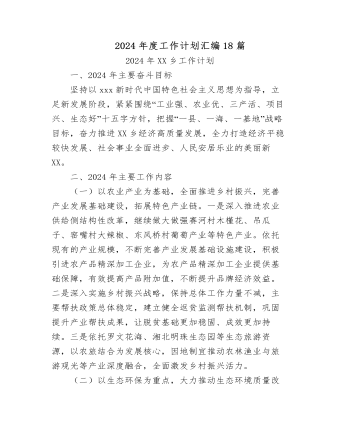
2024年度工作计划汇编(18篇)
1.市政基础设施项目5项,总建设里程2.13km,投资概算2.28亿元。其中,烔炀大道(涉铁)工程施工单位已进场,项目部基本建成,正在办理临时用地、用电及用水等相关工作;中铁佰和佰乐(巢湖)二期10KV外线工程已签订施工合同;黄麓镇健康路、纬四路新建工程均已完成清单初稿编制,亟需黄麓镇完成图审工作和健康路新建工程的前期证件办理;公安学院配套道路项目在黄麓镇完成围墙建设后即可进场施工。2.公益性建设项目6项,总建筑面积15.62万㎡,投资概算10.41亿元。其中,居巢区职业教育中心新建工程、巢湖市世纪新都小学扩建工程已完成施工、监理招标挂网,2月上旬完成全部招标工作;合肥职业技术学院大维修三期已完成招标工作,近期签订施工合同后组织进场施工;半汤疗养院净化和医用气体工程已完成招标工作;半汤疗养院智能化工程因投诉暂时中止;巢湖市中医院(中西医结合医院)新建工程正在按照既定计划推进,预计4月中下旬挂网招标。

驻村工作队2024年第一季度工作总结汇编(4篇)
三是做大做强海产品自主品牌。工作队于xx年指导成立的冬松村海产品合作社,通过与消费帮扶平台合作,在工作队各派出单位、社会团体、个人支持下,已获得逾xx万元销售额。2022年底工作队推动合作社海产品加工点扩建的工作方案已获批,待资金下拨后将正式启动扩建工作。四是积极助企纾困,带动群众增收致富。工作队利用去年建立的xx镇产业发展工作群,收集本地企业在产品销售、技术、人力、资金、运营、用地等方面的需求,并加大xx支持乡村振兴力度,xx助理赴各村委开展多场xx政策支持乡村振兴宣讲活动,本季度有x万元助农贷款获批,xx万贷款正在审批中。在壮大既有产业的同时,完善联农带农机制,一方面鼓励企业雇用本地农户就业,另一方面计划与本地农户签订长期收购合同,让农民种得放心、种得安心,带动当地群众共同致富。
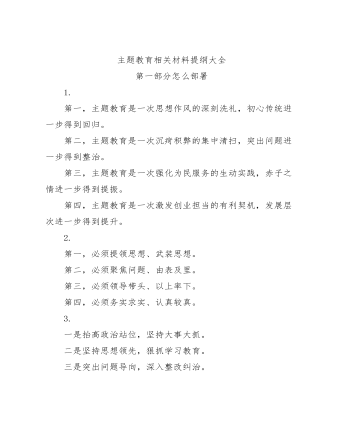
主题教育总结常用提纲大全
第一,主题教育是一次思想作风的深刻洗礼,初心传统进一步得到回归。第二,主题教育是一次沉疴积弊的集中清扫,突出问题进一步得到整治。第三,主题教育是一次强化为民服务的生动实践,赤子之情进一步得到提振。第四,主题教育是一次激发创业担当的有利契机,发展层次进一步得到提升。2.第一,必须提领思想、武装思想。第二,必须聚焦问题、由表及里。第三,必须领导带头、以上率下。第四,必须务实求实、认真较真。3.一是抬高政治站位,坚持大事大抓。二是坚持思想领先,狠抓学习教育。三是突出问题导向,深入整改纠治。四是坚持领导带头,发挥表率作用。4.一是立足“早”字抓筹划。二是着眼“活”字抓学习。三是围绕“统”字抓协调。5.一是形势所需。二是任务所系。三是职责所在。四是制度所定。6.一要提升认识。二要积极作为。三要密切协作。
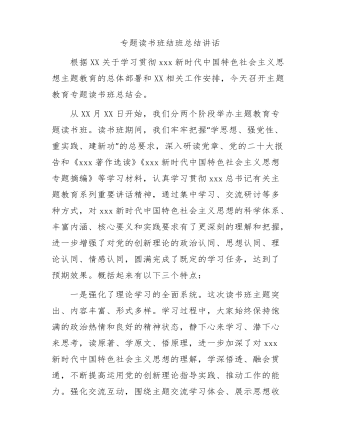
主题教育专题读书班结班总结讲话
第二,要把调查研究贯穿始终,实干担当促进发展。开展好“察实情、出实招”“破难题、促发展”“办实事、解民忧”专项行动,以强化理论学习指导发展实践,以深化调查研究推动解决发展难题。领导班子成员要每人牵头XX个课题开展调查研究,XX月底前召开调研成果交流会,集思广益研究对策措施。各部门、各单位要制定调研计划,通过座谈访谈、问卷调查、统计分析等方式开展调查研究,解决工作实际问题,帮助基层单位和客户解决实际困难。第三,要把检视问题贯穿始终,廉洁奉公树立新风。认真落实公司主题教育整改整治工作方案要求,坚持边学习、边对照、边检视、边整改,对标对表xxx新时代中国特色社会主义思想,深入查摆不足,系统梳理调查研究发现的问题、推动发展遇到的问题、群众反映强烈的问题,结合巡视巡察、审计和内外部监督检查发现的问题,形成问题清单。












